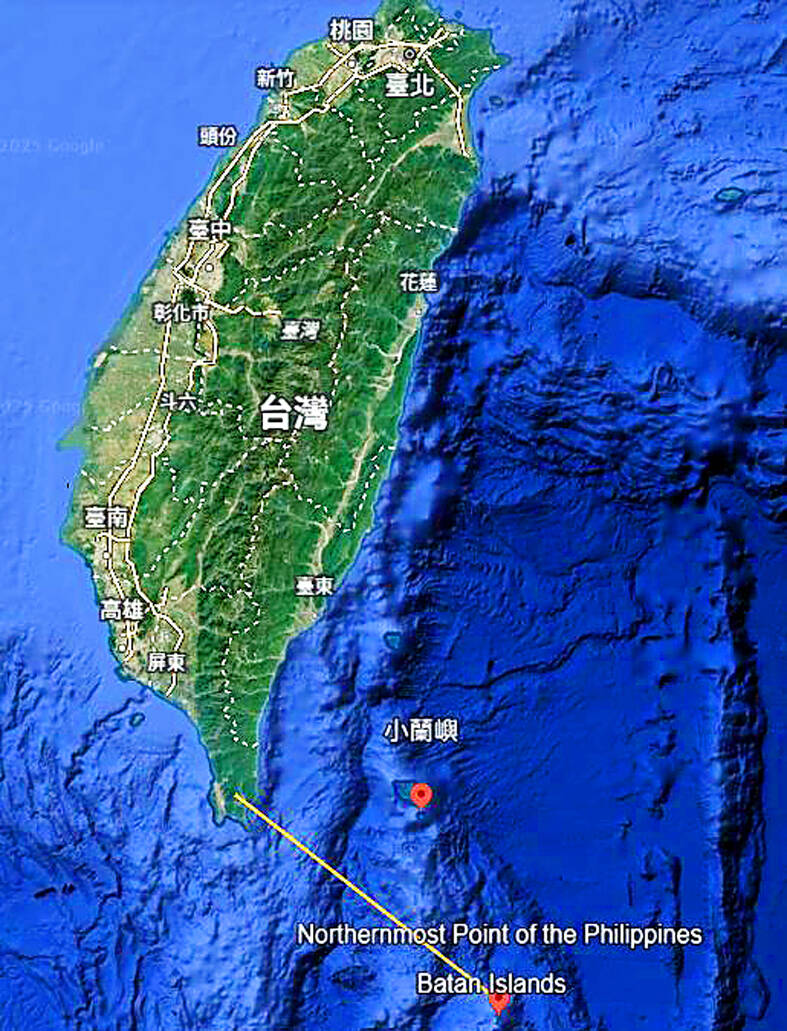A US Marine Corps regiment equipped with Naval Strike Missiles (NSM) is set to participate in the upcoming Balikatan 25 exercise in the Luzon Strait, marking the system’s first-ever deployment in the Philippines.
US and Philippine officials have separately confirmed that the Navy Marine Expeditionary Ship Interdiction System (NMESIS) — the mobile launch platform for the Naval Strike Missile — would take part in the joint exercise.
The missiles are being deployed to “a strategic first island chain chokepoint” in the waters between Taiwan proper and the Philippines, US-based Naval News reported.

Photo: Screen grab from Google Earth
“The Luzon Strait and Bashi Channel represent a critical access point to enter or exit the Pacific Ocean from the South China Sea and Taiwan Strait, and the deployment of NMESIS allows the US to assert control over that access,” Ben Lewis, a co-founder of PLATracker and an expert on the Chinese military, was quoted as saying.
The Naval Strike Missile has a reported operational range of more than 185km — just short of the 190km stretch of water that separates Taiwan proper from the Batanes Islands, the northernmost territory of the Philippines.
The Philippine News Agency on Tuesday said the US Marine Corps deployed an unspecified number of NMESIS launchers in the Philippines, citing Philippine Army Brigadier General Michael Logico.
Balikatan 25 is part of a larger joint exercise involving 3,000 Filipino and 2,000 US troops, a Philippine military spokesperson said in an earlier report.
The drills are designed to improve joint all-domain operational capabilities, enhance warfighting readiness and showcase the bilateral commitment to defending the Philippines’ territorial integrity, they were cited as saying.
Separately, the US Marine Corps on Wednesday confirmed that the Naval Strike Missile-armed 3rd Marine Littoral Regiment would participate in Balikatan 25.
During the exercise, several NMESIS launchers would be airlifted by US Army and Marine Corps aviation units to conduct maritime key terrain security operations across multiple islands in the Batanes, it said.
The regiment’s fire control center would coordinate its batteries in simulated missile strikes without live fire, it added.
“Working with the government and Armed Forces of the Philippines to bring the NMESIS into the Philippines has been a significant step in the right direction for the reaffirmation and strengthening of US-Philippine relations,” regiment commander Colonel John Lehane was quoted as saying.

FIREPOWER: On top of the torpedoes, the military would procure Kestrel II anti-tank weapons systems to replace aging license-produced M72 LAW launchers Taiwan is to receive US-made Mark 48 torpedoes and training simulators over the next three years, following delays that hampered the navy’s operational readiness, the Ministry of National Defense’s latest budget proposal showed. The navy next year would acquire four training simulator systems for the torpedoes and take receipt of 14 torpedoes in 2027 and 10 torpedoes in 2028, the ministry said in its budget for the next fiscal year. The torpedoes would almost certainly be utilized in the navy’s two upgraded Chien Lung-class submarines and the indigenously developed Hai Kun, should the attack sub successfully reach operational status. US President Donald Trump

TPP RALLY: The clashes occurred near the Chiang Kai-shek Memorial Hall on Saturday at a rally to mark the anniversary of a raid on former TPP chairman Ko Wen-je People who clashed with police at a Taiwan People’s Party (TPP) rally in Taipei on Saturday would be referred to prosecutors for investigation, said the Ministry of the Interior, which oversees the National Police Agency. Taipei police had collected evidence of obstruction of public officials and coercion by “disorderly” demonstrators, as well as contraventions of the Assembly and Parade Act (集會遊行法), the ministry said in a statement on Sunday. It added that amid the “severe pushing and jostling” by some demonstrators, eight police officers were injured, including one who was sent to hospital after losing consciousness, allegedly due to heat stroke. The Taipei

NO LIVERPOOL TRIP: Taiwan’s Lin Yu-ting, who won a gold medal in the boxing at the Paris Olympics, was embroiled in controversy about her gender at that event Taiwanese boxer Lin Yu-ting (林郁婷) will not attend this year’s World Boxing Championships in Liverpool, England, due to a lack of response regarding her sex tests from the organizer, World Boxing. The national boxing association on Monday said that it had submitted all required tests to World Boxing, but had not received a response as of Monday, the departure day for the championships. It said the decision for Lin to skip the championships was made to protect its athletes, ensuring they would not travel to the UK without a guarantee of participation. Lin, who won a gold medal in the women’s 57kg boxing

The US has revoked Taiwan Semiconductor Manufacturing Co’s (TSMC, 台積電) authorization to freely ship essential gear to its main Chinese chipmaking base, potentially curtailing its production capabilities at that older-generation facility. American officials recently informed TSMC of their decision to end the Taiwanese chipmaker’s so-called validated end user (VEU) status for its Nanjing site. The action mirrors steps the US took to revoke VEU designations for China facilities owned by Samsung Electronics Co and SK Hynix Inc. The waivers are set to expire in about four months. “TSMC has received notification from the US Government that our VEU authorization for TSMC Nanjing